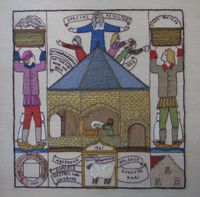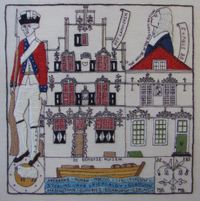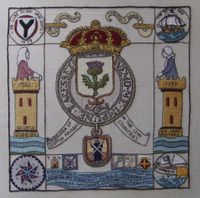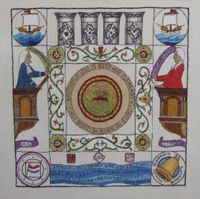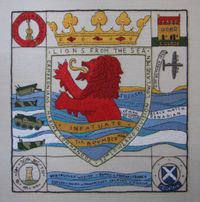De Veerse 'panelen' / The Veere 'panels'
Paneel 1. 'Princess Mary'.
Centrale figuren: Wolfert VI van Borsele, heer van Veere en Mary Stuart, dochter van koning James I van Schotland; getrouwd in 1444. Van de Schotse koning kreeg het bruidspaar de rechten op het graafschap Buchan, boven Aberdeen, cadeau. Dit huwelijk betekende een grote impuls voor de Schots-Veerse betrekkingen. In de vaandels op de achtergond: Veere, Sandenburgh (dit kasteel was de residentie van de Heren van Veere), Bruges (Veere volgde Brugge op als stapelplaats).
R.b.: wapen van Veere.
L.b.: Midden 15de eeuw kreeg een neef van Wolfert, Paulus van Borsele, de rechten over het graafschap Lauderdale in de Schotse Borders. In de Wijngaardstraat stond een stenen huis dat hij Laterdale noemde.Op diverse panelen worden de namen opgesomd van de toenmalige Schotse koopsteden, in de spelling van die tijd. De koopsteden, verenigd in de Convention of Royal Burghs, waren verplicht hun –met name genoemde– handel via Veere te laten verlopen.
Royal Burghs op dit paneel: Pettinweem (Pittenweem), Dunfermling (Dunfermline), Bruntyland (Burntisland), Arbroth (Arbroath), Elgin, Carraill (Crail), Kinghorn, Innerness (Inverness), Brechin, Kirkaldy (Kirkcaldy). In de hoeken van sommige panelen komen ‘tags’ voor, d.w.z. de ‘handtekeningen’ van de borduursters.
Panel 1. ‘Princess Mary’.
Key persons: Wolfert VI of Borsele, lord of Veere married Mary Stuart, daughter of King James1 in 1444. The Scottish king presented them as a wedding gift with county Buchan, situated north of Aberdeen. This marriage meant a great impulse to the ties between Scotland and the city of Veere.
The banners in the background show: Veere, Castle Sandenburgh (residence of the Lords of Veere), Bruges (the city holding the Scottish Staple before it was transferred to Veere).
Top right: coat of arms of city of Veere.
Top left: In the middle of the 15th century a cousin of Wolfert by the name of Paulus van Borsele was awarded the county of Lauderdale in the Scottish Borders. He then named a brick built house in the Wijngaardstraat: “Laterdale”.
On various panels you’ll find names of former Royal Scottish trading cities in their authentic spelling. These trading cities, united in the Convention of Royal Burghs, were obliged to have all the “dedicated” merchandise destined for Europe, shipped via the city of Veere.
The Royal Burghs on this panel are: Pettinweem (Pittenweem), Dunfermling (Dunfermline), Bruntyland (Burntisland), Arbroth (Arbroath), Elgin, Carraill (Crail), Kinghorn, Innerness (Inverness), Brechin, Kirkaldy (Kirkcaldy).
In the corners of some of the panels you can find ‘tags’, being the ‘signatures’ of the makers (stitchers).
Paneel 2. ‘Special privileges’.
Centraal thema: de cisterne. In het Stapelcontract (staple contract) van 1541 was sprake van de aanleg van een waterput ten behoeve van de ‘cooplieden’. In 1543 werd er een zeer geavanceerd, grotendeels ondergronds, waterreservoir aangelegd. De put werd gebruikte door de Schotse wolhandelaren. In 1551 werd deze van een overkapping voorzien, een achthoekig natuurstenen gebouwtje voorzien van tudorbogen.
In 1550 waren van de ca. 3500 Veerse inwoners zo’n 400 van Schotse origine. De Schotten genoten ‘special privileges’; zo hoefden zij geen belasting op hun wijn en bier te betalen (no tax for wine and beer). Daarnaast mochten ze onder hun eigen rechtsregels leven (judges) en hun eigen godsdienst uitoefenen. Functionarissen als chirurgijn en conciërge van het Schotse Huis (doctor, innkeeper) werden door de conservator benoemd (zie ook paneel 4).
Rechtermarge: koopman met de exportproducten uit de Nederlanden: linen (linnen) en pan tiles (dakpannen; deze werden m.n. vervoerd als ballast op de terugreis).
Linkermarge: koopman met de importproducten uit Schotland: wol, boter, steenkool, zalm, huiden, leer (wool, salmon, butter, leather, coal, hides).
Onder: gevelsteen van Het Lammetje, samen met De Struys in 1539 gebouwd door de Schotse koopman Joos Oliviers. Andere Veerse huisnamen die herinneren aan de Schotse handel: Aberdaam, Domfris, Kasteel van Edinburg, Wolsack. Een deel van de kade, tussen de brug en de Markt, was gereserveerd voor de schepen uit Schotland en heette dan ook Schotse kaai.
R.o.: veel huizen aan de Schotse oostkust hebben Hollands aandoende trapgevels en zijn gedekt met Hollandse dakpannen.
Panel 2. ‘Special privileges’.
Theme: the cistern. In the staple contract of 1541 it was agreed that a well would be dug for the traders (in old Dutch: “cooplieden”). In 1543 a mainly underground water storage facility was built. The Scottish wool traders used the well. In 1551 the well was roofed over by means of an octagonal stone building with Tudor-style supports. In 1550 of the roughly 3500 inhabitants of Veere some 400 were of Scottish origin. The Scots were granted special privileges; they were exempted from paying taxes on wine and beer. In addition they were entitled to practice their own jurisdiction and religion (Scottish judges and clergymen). The Lord Conservator appointed a doctor for the Scottish citizens and an innkeeper of the Scottish House (see also panel 4). To the right: A merchant with export products from the Netherlands: linen and pan tiles (roofing tiles; the latter also used as ballast for the vessels on their return journey).To the left: A merchant with products imported from Scotland: wool, salmon, butter, leather, coal and hides. Below: Plaque of het Lammetje (the little lamb), building built in 1539 together with De Struys (the Ostrich) by Scottish businessman Joos Oliviers. Quite a few residential buildings in Veere carry names that remind us of the trade with Scotland: Aberdaam, Domfris, Kasteel van Edinburg, Wolsack. Part of the quayside (Kaai or Kade), between bridge and market was dedicated to the mooring of vessels coming from Scotland. It was named Schotse Kaai. Right bottom: many houses on the Scottish east coast (East Neuk region) have stepped gables that resemble the ones in the Netherlands. Likewise the roofs are covered in (Dutch) pan tiles.
Paneel 3. ‘Scots House’.
In de vijftiende eeuw gingen de zaken goed. Veel Schotten lieten fraaie huizen aan de Kaai en de Markt bouwen; veel huisnamen herinneren nog aan deze welvarende tijd (zie paneel 2). Tegenwoordig staan zowel Het Lammeken als De Struys bekend onder de naam ‘De Schotse Huizen’. In feite was alleen De Struys het ‘Schotse Huis’, toen het in 1764 door de stad Veere aan de Conservator van de Schotse Privileges in gebruik werd gegeven, als het officiële House of the Scottish Nation. Tussen 1614 en 1764 stond het Schotse natiehuis in de Wijngaardstraat.
Linkermarge: fuselier uit het regiment nr. 22 der Houston Schotten, in Staatse dienst tussen 1779 en 1782, gelegerd in Veere. Militairen waren in Veere ondergebracht in verspreid binnen de stad liggende kazernes.
R.o.: muuranker van Het Lammetje, waarin een distel is verwerkt, de nationale plant van Schotland.
L.o.: wederom een afbeelding van een lam, een verwijzing naar het belangrijkste importproduct, de Schotse wol.
Royal Burghs: Aberdeine (Aberdeen), Dundie (Dundee), Irwing (Irvine), Linlithgow, Sterling (Stirling), Ayr, Kirkcaldy, Glasgow, Hadingtoun (Haddington), Dumfries, Edinburgh, Iedburgh (Jedburgh).
Panel 3. ‘Scots House’.
In the 15th century business was prosperous. Many Scotsmen had beautiful houses built at de Kaai (the Quayside) and at de Markt (the Market square); many of the names these houses carry remind us of this time of prosperity (see panel 2). Nowadays the buildings Het Lammetje and De Struys are known as (Museum) ‘De Schotse Huizen’. As a matter of fact, only ‘De Struys’ was the ‘Scottish House’ when it was handed over by the mayor of Veere to the Conservator of the Scottish Privileges as the official House of the Scottish Nation. Between 1614 and 1764 there was a(nother) Scottish Nation House in the Wijngaardstraat.
To the left: fusilier regiment no. 22 Houston Scots, serving in the Netherlands Army between 1779 and 1782, based at Veere. Soldiers in Veere were quartered at various barracks within the city boundary.
Right bottom: wall clamp (anchor) of het Lammetje, depicting a thistle, Scotland’s national flower.
Left bottom: again a picture of a lamb, reference to the most important product traded, wool from Scotland.
Royal Burghs: Aberdeine (Aberdeen), Dundie (Dundee), Irwing (Irvine), Linlithgow, Sterling (Stirling), Ayr, Kirkcaldy, Glasgow, Hadingtoun (Haddington), Dumfries, Edinburgh, Iedburgh (Jedburgh).
Paneel 4. ‘Conservator’.
De controle op de naleving van alle voorrechten werd door de Schotse steden toevertrouwd aan een Conservator van de Schotse Privileges in de Nederlanden. De conservator, een soort consul dus, stond aan het hoofd van de Schotse gemeenschap; hij bestuurde die samen met een ‘deputy’. In de Franse tijd werden de Schotse privileges opgeheven en in 1799 kwam er een definitief eind aan de Schotse handel. Langzamerhand verliet de Schotse gemeenschap Veere.
Midden: de erepenning van de Conservator of Scottish Privileges in the Low Countries, met de Latijnse tekst Nemo me impune lacesset (moet zijn: lacessit). Dit is het motto dat eigenlijk bij de Orde van de Distel hoort, de hoogste onderscheiding in Schotland. De betekenis: ‘niemand raakt mij ongestraft’, kan zowel op de drager als op de distel slaan.
Een van de bewoners van Het Lammetje was Thomas Cunningham, een koopman die veel rijkdom vergaarde met het verschepen van duizenden musketten van Veere naar Schotland. Deze wapens waren bestemd voor Schotten die in de Engelse Burgeroorlog (1642-1649) in opstand waren gekomen, omdat de koning hen een andere kerkorganisatie wilde opleggen. Zijn trouw aan Schotland bleek ook uit een door hem ontworpen ‘Thrissels Banner’: een vlag met een gedicht waarin hij zijn gal spuwt over de Engelsen.
Linkermarge: George Gordon 1541, de eerste conservator.
Rechtermarge: Sir James Crauford 1799, de laatste conservator.
L.B.: De Iure Regni Apud Scotos 1579 (‘A Dialogue concerning the Rights of the Crown in Scotland’), geschreven in ballingschap door de Schotse historicus en humanist George Buchanan. Deze publicatie was een aanklacht tegen het koningschap, en was daarom in Schotland en Engeland verboden. Het werk werd gedrukt in de Nederlanden en via de Schotse stapel naar Schotland gesmokkeld.
R.B.: The bullet 1663. (?)
R.O.: St. Andrews. In het stadhuis van Veere hangt een schilderij waarop alle schepen staan afgebeeld die in het jaar 1651 de haven van Veere aandeden. Eén schip voert een rode oorlogsvlag met in de hoek de Schotse ‘saltyre’-vlag. Op enkele luiken is het schild van Saint Andrew te zien. Saint Andrew (Andreus) is de nationale heilige van Schotland. Volgens een bijbehorende lijst zou dit het schip ‘Seelandia’ moeten zijn. Het gaat hier echter om het Schotse oorlogsschip Saint Andrews, dat in 1651 van Lissabon op weg was naar Groot-Brittannië. Op deze reis heeft het ook de rede van Veere aangedaan. In het oud-Nederlandse handschrift is ‘St Andrews’ waarschijnlijk voor ‘Seelandia’ aangezien.
Royal Burghs: Kirkudbright (Kirkcudbright), Wigtoun (Wigtown), Dumbarton, Renfrew, Lanerik (Lanark), Pebils (Peebles), Selkirk, Dumbar (Dunbar), Whithorn, Rothsay (Rothesay), Ruthglen (Rutherglen), Lawder (Lauder).
Panel 4. 'Conservator'.
The Scottish trading Cities entrusted supervision on the compliance with the privileges to the Conservator of the Scottish Privileges in the Low Countries (the Netherlands). Acting as a sort of Consul the Conservator was head of the Scottish community; he governed it together with his ‘deputy’. When the French ruled the Netherlands all privileges for the Scots were abolished and by 1799 the trade with Scotland came to a halt. Gradually the Scottish community left Veere.
Middle: The Badge of Honour of the Conservator of the Scottish Privileges in the Low Countries, with a text in Latin Nemo me impune lacesset (should be: lacessit). This is the motto of the Order of the Thistle, the highest decoration in Scotland. The meaning: “nobody can touch me without punishment” (free translation) can refer to the bearer as well as to the thistle.
One of the residents of Het Lammetje (the Lamb) was a certain Thomas Cunningham, a businessman, who earned a fortune by shipping out thousands of muskets from Veere to Scotland. These weapons went to the Scots fighting the English in the civil war of 1642 – 1649. The main reason for that resurrection was that the king tried to impose a different religious order upon his people. Thomas Cunningham’s loyalty to Scotland became also visible through the so-called Thrissels Banner designed by him. This banner carried a poem in which he vented his gall on the English.
Left margin: George Gordon 1541, the first conservator.
Right margin: Sir James Crauford 1799, the last conservator.
Top left: De lure Regni Apud Scotos 1579, (‘A dialogue concerning the Rights of the Crown in Scotland’) written whilst in exile by the Scottish historian and humanist George Buchanan. This publication was a charge against the Crown, and for that reason suppressed in Scotland and England.
The publication was printed in the Netherlands and smuggled through the Scottish Staple to Scotland.
Top right: the Bullet 1663 (no further explanation given)
Right bottom: St. Andrews. In the city of Veere’s town hall there is a painting depicting all the ships that sailed into the port of Veere in the year 1651. One vessel was sailing a red flag of war with in the corner the (Scottish) saltyre (saltire). At some of the covers of its gun ports one can spot the Saint Andrew arms. Saint Andrew is the (national) saint of Scotland.
According to the accompanying summary the vessels name is “Seelandia” (Zeeland). This is in fact incorrect as it concerns the Scottish man of war Saint Andrews that called at Veere whilst on its way from Lisbon to Great Britain. In the old Dutch script St Andrews could have been mistaken for Seelandia.
Royal Burghs: Kirkudbright (Kirkcudbright), Wigtoun (Wigtown), Dumbarton, Renfrew, Lanerik (Lanark), Pebils (Peebles), Selkirk, Dumbar (Dunbar), Whithorn, Rothsay (Rothesay), Ruthglen (Rutherglen), Lawder (Lauder).
Paneel 5. ‘Kirk’.
Voor het inzegenen van huwelijken, het dopen van kinderen en het begraven van doden beschikte de Schotse gemeenschap over een eigen kerk en kerkhof.
De Schotse kerk was verbonden aan de synode in Edinburgh en werd in 1613 de eerste Schotse protestantse kirk op het vasteland van Europa. De diensten werden gehouden in de noordelijke beuk van het van de Grote kerk afgescheiden hallenkoor. Linkermarge: rev. Alexander McDuff 1614, de eerste predikant.
Rechtermarge: in 1799 werd de Schotse kerkgemeenschap opgeheven. De laatste dominee, rev. Lickly liet ter afsluiting in de emotionele afscheidsdienst o.m. Psalm 122:2-3 zingen, ‘met groote aandoening door hem en zijn gemeente’.
Beide predikanten zijn afgebeeld op de preekstoel van de Schotse kerk. In 1837 werd deze verkocht aan de hervormde kerk van Westkapelle. In 1686 had de preekstoel de grote brand van de Grote kerk overleefd, maar hij ging alsnog verloren tijdens branden na de bombardementen op Westkapelle van 1944.
Bovenmarge: In 1620 gaf de kerkgemeenschap opdracht aan Isak de Cliever, zilversmid te Middelburg, vier gegraveerde avondmaalsbekers te maken. De bekers zijn gemaakt van zilver en zijn ongeveer 16 cm hoog, hebben ingegraveerde ringen en versierde banden en dragen het jaartal 1620.
Centraal motief: de bodem ervan, met het opschrift: Brotherlie Love is Good and Pleasant (Psalm 133), met daarbij een pijlenbundel die door een band bijeen wordt gehouden. In vierkant kader met weergave van de graveringen.
R.o.: Michael Burgerhuis, Middelburgh, Nethergate. Volgens de overlevering zouden er in 1621 drie klokken gegoten zijn ‘at Campvere in Zeeland’. Twee waren bestemd voor de St. Giles’ kerk in Edinburgh en een derde voor de klokkentoren van de Netherbow poort. De inscriptie van één klok die tegenwoordig in de Dean Gallery (Scottish Storytelling Center) te Edinburgh hangt, toont aan dat de klok niet in Veere, maar in Middelburg is gegoten, door Michael Burgerhuis.
Royal Burghs: Annan, Lochmaban (Lochmaben), Sancher (Sanquhar), Galloway, Queensferry, Perth, Saint Andros (Saint Andrews), Dysert (Dysart), Montrose, Cowpar (Cupar), Anstuther Easter (Anstruther), North Berwick, St. Ilhonstoun (Johnstone).
Panel 5. 'Kirk'.
To perform marriage services, baptizing children and holding funeral services the Scots in Veere had their own church and burial ground.
The Scottish Church in Veere was attached to the Edinburgh Synod and became the first Scottish protestant kirk in continental Europe in 1613. Services were held in the northern section of the hall chancel that was separated from Veere’s main church.
Left margin: Reverend Alexander McDuff 1614, the first clergyman.
Right margin: In 1799 the Scottish Church in Veere was discontinued. The last clergyman, reverend Lickly held a very emotional farewell service in which the community sang Psalm 122:2-3 ‘met groote aandoening door hem en zijn gemeente’. (Free translation: ‘he and his church community suffering deeply emotionally’).
Both clergymen can be seen on the pulpit of the Scottish Kirk. This pulpit was sold to the reformed church of Westkapelle in 1837. In 1686 it had survived a great fire in the Grote Kerk (the large church in Veere), unfortunately however it was lost in the allied bombardments at Westkapelle in 1944.
Upper margin: in 1620 the church community ordered from Isak de Cliever, a silversmith from Middelburg, four engraved Communion goblets. The goblets with a height of some 16 centimeters are made from silver, carry circular engravings and bear the year 1620 as date.
Central motive: the bottom of the goblets with the inscription: Brotherlie Love is Good and Pleasant (Psalm 133). Furthermore there is a bundle of arrows held together by a wide string.
In a square cadre showing the engravings.
Right bottom: Michael Burgerhuis, Middelburgh, Nethergate. There is a story that three church bells were founded in 1621 ‘at Campvere in Zeeland’. Two of these were destined for the St. Giles church in Edinburgh, the third one for the Netherbow gate. However the inscription in one of the bells now hanging in the Dean Gallery in Edinburgh (the Scottish Storytelling Centre) discloses that the bell was not founded in Veere (Campvere) but in Middelburgh (now: Middelburg) by Michael Burgerhuis.
Royal Burghs: Annan, Lochmaban (Lochmaben), Sancher (Sanquhar), Galloway, Queensferry, Perth, Saint Andros (Saint Andrews), Dysert (Dysart), Montrose, Cowpar (Cupar), Anstuther Easter (Anstruther), North Berwick, St. Ilhonstoun (Johnstone).
Paneel 6. 'Infatuate'.
De operatie ‘Infatuate’ (1-8 november 1944) betrof de bevrijding van het door de Duitsers bezette Walcheren, een beslissende fase in de strijd om de Scheldemonding, de toegang tot Antwerpen. Bij de Slag om Walcheren waren troepen van Britse, Franse, Canadese, Nederlandse, Belgische en Noorse nationaliteit betrokken. Op 11 oktober 1944 (11th October 1944) werden eerst de dijken rondom Walcheren vanuit geallieerde vliegtuigen gebombardeerd, teneinde het eiland onder water te zetten. Daarnaast vonden hevige gevechten plaats. Veere werd op 7 november 1944 (7th November) bevrijd door Schotse troepen, m.n. die van de 156de Infantry ‘Mountain’ Brigade, bestaande uit de 6de en 7de Cameronians ‘Scottish Rifles’ (o.l.v. C.F. Nason), het 5de van de HLI (Highland Light Infantry), de 1ste Glasgow Highlanders, de Royal Engineers en Royal Artillery, alle behorend tot de 52nd Lowland Division o.l.v. E. Hakewill Smith.
Nason schreef later hierover: “In the early morning (…) I looked across the flat fields of Walcheren and saw Veere with its beautiful Town Hall and Cathedral on its northern boundary. My immediate thoughts were: what a terrible crime it would be to destroy this lovely old town with its historic connections with the wool trade of Scotland and the very heavy civilian casualties which would result”. De stad overleefde de oorlog vrijwel onaangetast.
Bij de bevrijding van Walcheren waren onder anderen ook Marine Commandos, Special Service Brigades, Lowland Men, Fusiliers, Lothian Yeomen, Black Watch Canadians, Calgary Highlanders, King’s Own Scottish Borderers betrokken, ware ‘leeuwen’ van de zee dus (Lions of the sea). De capitulatie werd op 8 november in Vrouwenpolder ondertekend.
Midden: variatie op het Wapen van Zeeland. De klimmende leeuw komt ook voor op het wapen van Schotland (‘the ramping lyon’), maar in Zeeland zijn daarnaast op de onderste helft zes golvende banen afgebeeld.
R.b.: Culross in Fife, een van de koninklijke Schotse koopsteden waar Veere vriendschapsbanden mee onderhoudt. Afgebeeld is het zgn. ‘Palace’, een koopmanshuis uit 1597.
L.b.: The Holland trade.
Royal Burghs: Anstruther Wester, Banff, Forfar, Forres, Cullan (Cullen), Nairn, Innerkethen (Inverkeithing), Kilrany (Kilrenny), Thaine (Tain).
Panel 6. 'infatuate'.
Operation ‘Infatuate’ (November 1-8, 1944) concerned the liberation of Walcheren, then occupied by the Germans, a crucial phase in the battle of the river Scheldt, the access to the port of Antwerp.
In the Battle of Walcheren troops of many nationalities were engaged, Brits, French, Canadians, Dutch, Belgians and Norwegians. On October 11 the dykes (sea defenses) of the isle of Walcheren were bombarded by allied air forces, thus flooding the isle. Subsequent heavy fighting took place to get the German forces out. Veere was liberated on November 7, 1944 by Scottish troops. These were the 156th Infantry Mountain Brigade consisting of 6th and 7th Cameronians (‘Scottish Rifles’ with commanding officer C.F. Nason), 5th Company of the HLI (Highland Light Infantry), 1st Glasgow Highlanders (HLI) of the 52nd Lowland Division (lead by E. Hakewell Smith), along with the Royal Engineers and Royal Artillery.
Nason wrote about this episode the following: “In the early morning (…) I looked across the flat fields of Walcheren and saw Veere with its beautiful Town Hall and Cathedral on its northern boundary. My immediate thoughts were: what a terrible crime it would be to destroy this lovely old town with its historic connections with the wool trade of Scotland and the very heavy civilian casualties which would result”. The city of Veere survived the war virtually unharmed.
In the liberation of Walcheren other troops involved came from the (Royal) Marine Commandos, Special Services Brigade, Lowland Men, Fusiliers, Lothian Yeomen, Black Watch Canadians, Calgary Highlanders and the King’s Own Scottish Borderers. The German surrender was declared at Vrouwenpolder on November 8, 1944.
Middle: Variation in the Coat of arms (of the province) of Zeeland. The climbing lion also shows in the arms of Scotland (‘the ramping lyon’). In Zeeland however the lower part shows six ‘waves’ of the sea.
Right bottom: Culross in Fife, one of the Royal Scottish trading cities Veere has entered into a bond of friendship with. Shown is the so-called ‘Palace’, the residence of a tradesman built in 1597.
Left bottom: ‘The Holland trade’.
Royal Burghs: Anstruther Wester, Banff, Forfar, Forres, Cullan (Cullen), Nairn, Innerkethen (Inverkeithing), Kilrany (Kilrenny), Thaine (Tain).



